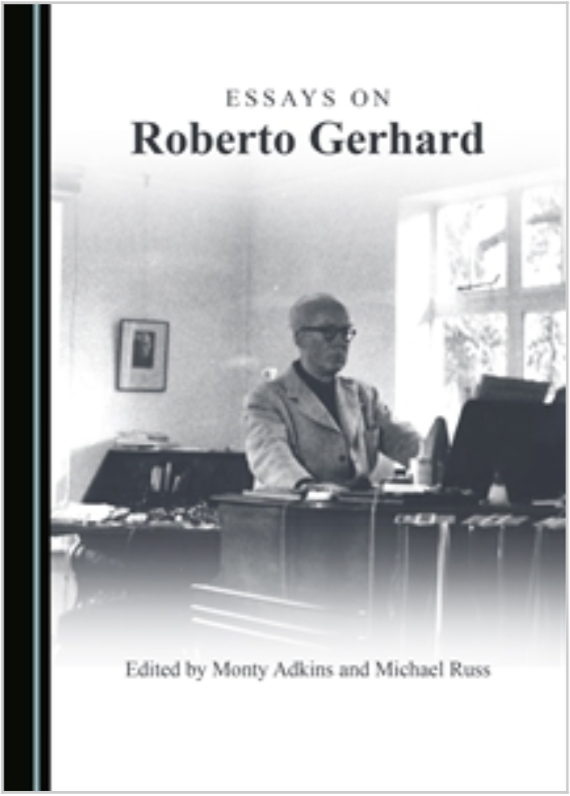The wide range of topics covered by the ten articles in Essays on Gerhard demonstrate the fact that he was a man whose intellectual curiosity lead him to explore many idioms in some depth, an aspect of his work which could have resulted in an oeuvre that is merely an idiosyncratic collection of individual works. Instead, the overlaps and cross-currents between articles generate a perception that there was a constancy in his explorations of these idioms which eventually produced the syntheses of his late works and enabled him to embrace even the seemingly alien aesthetic of John Cage.
The principal focus of the chapters discussing his musical development is on Gerhard’s development as a serialist, and the essays range over his early explorations of irregular series in the Wind Quintet of 1928 (Rachel Mitchell) and the ballet Don Quixote, begun in 1940 (Trevor Walshaw); his theorising in the late 40s and early 50s (Russ) and his application of the series not only to the organisation of pitch but also to temporal structures (Darren Sproston).
The electronic explorations are represented with a detailed analysis by Gregorio García Karman of the setting of the poem by Gerhard’s friend Lorca Lament for the Death of a Bullfighter. Karman’s analysis embraces not only the materials and structure created by the composer and their relationship with the text, but also reflects on the implications of the choice of text and its personal significance for Gerhard.
In discussing the ballets both White, who examines for the first time the relationship between music and scenario in the original Pandora ballet, and Walshaw in his detailed study of Don Quixote, place some emphasis on Gerhard’s emotional commitment to these projects: White comments on Gerhard’s and Jooss’s anti-war stance in Pandora, while Walshaw sees Don Quixote as both an expression of Gerhard’s vision of Cervantes’ hero as the personification of the psyche of Spain in times of strife and an assertion of his identity as a Spaniard, as opposed to the Catalan persona apparent in Pandora.
Gerhard, as is well-known, went into exile in 1939 and the common view in Britain has been that under Franco the works of the exiles were banned. However, the essay by Belén Pérez Castillo reveals that the situation was much more complex and she opens new perspectives for English-speaking readers. Pérez demonstrates that from about 1943 the musical literature began to include observations about exiled composers and it is shown that the causes of Gerhard’s low profile in the these writings are found not so much in the fact of his exile but in his aesthetic move away from nationalism towards association with the avant garde of Central Europe – Schoenberg, Webern, etc., combined with a degree of personal and political antipathy from the leading Francoist writer, Sopeña, although he did become a significant figure for the younger generation from the 1960s onwards.
Gerhard’s life and music are rich in ambiguities (he once wrote to Leo Black ‘I reserve the right to be inconsistent’) and in the coda to the book Duque and Adkins seize the opportunity to provide a commentary on Gerhard’s aesthetic by embracing and exploring the ambiguity inherent in the fact that, as he made clear in his notebooks, Gerhard, the great craftsman, was temperamentally resistant to Cage’s concept of the ‘open work’, but nevertheless was prepared to produce such a piece for Cage’s collection of scores. A second ambiguity is that we do not know whether Gerhard was being serious or ironic – nor, probably, will we ever.
As a Spaniard of Catalan birth, Franco-Swiss parentage and eventual British citizenship, who studied with both the father of Spanish musical nationalism (Pedrell) and the inventor of serialism (Schoenberg), Gerhard assimilated some of the most diverse musical currents of his time. In a career spanning five decades he completed a remarkable odyssey of exploration and self-discovery. All the more striking then that, when this compilation of essays on Gerhard is viewed as a whole, it is possible to discern a coherence in Gerhard’s life-long explorations, from the first efforts with irregular series through the advanced harmonic writing of Pandora to the syntheses of the dazzlingly inventive works of his fertile late period..
http://www.cambridgescholars.com/essays-on-roberto-gerhard
Trevor Walshaw and Julian White

